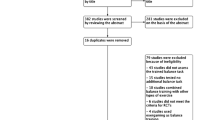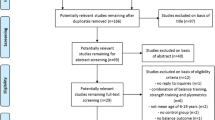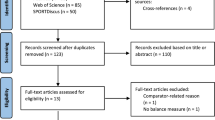Abstract
Background
Balance training (BT) has been used for the promotion of balance and sports-related skills as well as for prevention and rehabilitation of lower extremity sport injuries. However, evidence-based dose-response relationships in BT parameters have not yet been established.
Objective
The objective of this systematic literature review and meta-analysis was to determine dose-response relationships in BT parameters that lead to improvements in balance in young healthy adults with different training status.
Data Sources
A computerized systematic literature search was performed in the electronic databases PubMed, Web of Knowledge, and SPORTDiscus from January 1984 up to May 2014 to capture all articles related to BT in young healthy adults.
Study Eligibility Criteria
A systematic approach was used to evaluate the 596 articles identified for initial review. Only randomized controlled studies were included if they investigated BT in young healthy adults (16–40 years) and tested at least one behavioral balance performance outcome. In total, 25 studies met the inclusion criteria for review.
Study Appraisal and Synthesis Methods
Studies were evaluated using the physiotherapy evidence database (PEDro) scale. Within-subject effect sizes (ESdw) and between-subject effect sizes (ESdb) were calculated. The included studies were coded for the following criteria: training status (elite athletes, sub-elite athletes, recreational athletes, untrained subjects), training modalities (training period, frequency, volume, etc.), and balance outcome (test for the assessment of steady-state, proactive, and reactive balance).
Results
Mean ESdb demonstrated that BT is an effective means to improve steady-state (ESdb = 0.73) and proactive balance (ESdb = 0.92) in healthy young adults. Studies including elite athletes showed the largest effects (ESdb = 1.29) on measures of steady-state balance as compared with studies analyzing sub-elite athletes (ESdb = 0.32), recreational athletes (ESdb = 0.69), and untrained subjects (ESdb = 0.82). Our analyses regarding dose-response relationships in BT revealed that a training period of 11–12 weeks (ESdb = 1.09), a training frequency of three (mean ESdb = 0.72) or six (single ESdb = 1.84) sessions per week, at least 16–19 training sessions in total (ESdb = 1.12), a duration of 11–15 min for a single training session (ESdb = 1.11), four exercises per training session (ESdb = 1.29), two sets per exercise (ESdb = 1.63), and a duration of 21–40 s for a single BT exercise (ESdb = 1.06) is most effective in improving measures of steady-state balance. Due to a small number of studies, dose-response relationships of BT for measures of proactive and reactive balance could not be qualified.
Limitations
The present findings must be interpreted with caution because it is difficult to separate the impact of a single training modality (e.g., training frequency) from that of the others. Moreover, the quality of the included studies was rather limited, with a mean PEDro score of 5.
Conclusions
Our detailed analyses revealed effective BT parameters for the improvement of steady-state balance. Thus, practitioners and coaches are advised to consult the identified dose-response relationships of this systematic literature review and meta-analysis to implement effective BT protocols in clinical and sports-related contexts. However, further research of high methodological quality is needed to (1) determine dose-response relationships of BT for measures of proactive and reactive balance, (2) define effective sequencing protocols in BT (e.g., BT before or after a regular training session), (3) discern the effects of detraining, and (4) develop a feasible and effective method to regulate training intensity in BT.











Similar content being viewed by others
References
Zech A, Hubscher M, Vogt L, Banzer W, Hansel F, Pfeifer K. Balance training for neuromuscular control and performance enhancement: a systematic review. J Athl Train. 2010;45(4):392–403.
Hübscher M, Zech A, Pfeifer K, Hansel F, Vogt L, Banzer W. Neuromuscular training for sports injury prevention: a systematic review. Med Sci Sports Exerc. 2010;42(3):413–21.
Zech A, Hubscher M, Vogt L, Banzer W, Hansel F, Pfeifer K. Neuromuscular training for rehabilitation of sports injuries: a systematic review. Med Sci Sports Exerc. 2009;41(10):1831–41.
Taube W, Gruber M, Gollhofer A. Spinal and supraspinal adaptations associated with balance training and their functional relevance. Acta Physiol. 2008;193(2):101–16.
Taube W, Gruber M, Beck S, Faist M, Gollhofer A, Schubert M. Cortical and spinal adaptations induced by balance training: correlation between stance stability and corticospinal activation. Acta Physiol. 2007;189(4):347–58.
Granacher U, Gollhofer A, Kriemler S. Effects of balance training on postural sway, leg extensor strength, and jumping height in adolescents. Res Q Exerc Sport. 2010;81(3):245–51.
Rasool SI, George K. The impact of single-leg dynamic balance training on dynamic stability. Phys Ther Sport. 2007;8(4):177–84.
Oliveira AS, Brito Silva P, Farina D, Kersting UG. Unilateral balance training enhances neuromuscular reactions to perturbations in the trained and contralateral limb. Gait Posture. 2013;38(4):894–9.
Hoffmann J. Physiological aspects of sport training and performance. Champaign: Human Kinetics Pub Inc; 2002.
DiStefano LJ, Clark MA, Padua DA. Evidence supporting balance training in healthy individuals: a systemic review. J Strength Cond Res. 2009;23(9):2718–31.
Farlie MK, Robins L, Keating JL, Elizabeth M, Haines TP. Intensity of challenge to the balance system is not reported in the prescription of balance exercises in randomised trials: a systematic review. J Physiother. 2013;59(4):227–35.
Shumway-Cook A, Woollacott MH. Motor control: translating research into clinical practice. 4th ed. Philadelphia: Lippincott; 2007.
Lesinski M, Muehlbauer T, Busch D, Granacher U. Effects of complex training on strength and speed performance in athletes: a systematic review. Sportverletz Sportschaden. 2014;28(2):85–107.
Maher CG, Sherrington C, Herbert RD, Moseley AM, Elkins M. Reliability of the PEDro scale for rating quality of randomized controlled trials. Phys Ther. 2003;83(8):713–21.
Cohen J. Statistical power for the behavioral sciences. Hillsdale: Erlbaum; 1988.
Hrysomallis C. Balance ability and athletic performance. Sports Med. 2011;41(3):221–32.
France EP, Derscheid G, Irragang J, Malone T, Petersen R, Tippett S, Wilk K. Preliminary clinical evaluation of the Breg KAT: effects of training in normals. Isokinet Exerc Sci. 1992;2(3):133–9.
Gruber M, Taube W, Gollhofer A, Beck S, Amtage F, Schubert M. Training-specific adaptations of H- and stretch reflexes in human soleus muscle. J Mot Behav. 2007;39(1):68–78.
Cox ED, Lephart SM, Irrgang JJ. Unilateral balance training of noninjured individuals and the effects on postural sway. J Sport Rehabil. 1993;2:87–96.
Verhagen E, Bobbert M, Inklaar M, van Kalken M, van der Beek A, Bouter L, van Mechelen W. The effect of a balance training programme on centre of pressure excursion in one-leg stance. J Biomech. 2005;20(10):1094–100.
Gioftsidou A, Malliou P, Pafis G, Beneka A, Godolias G, Maganaris CN. The effects of soccer training and timing of balance training on balance ability. Eur J Appl Physiol. 2006;96(6):659–64.
Gioftsidou A, Malliou P, Pafis G, Beneka A, Tsapralis K, Sofokleous P, et al. Balance training programs for soccer injuries prevention. J Hum Sport Exerc. 2012;7(3):639–47.
Malliou P, Gioftsidou A, Pafis G, Beneka A, Godolias G. Proprioceptive training (balance exercises) reduces lower extremity injuries in young soccer players. J Back Musculoskelet Rehabil. 2004;17(3):101–4.
Malliou P, Amoutzas K, Theodosiou A, Gioftsidou A, Mantis K, Pylianidis T, Kioumourtzoglou E. Proprioceptive training for learning downhill skiing. Percept Mot Skills. 2004;99(1):149–54.
Romero-Franco N, Martinez-Lopez E, Lomas-Vega R, Hita-Contreras F, Martinez-Amat A. Effects of proprioceptive training program on core stability and center of gravity control in sprinters. J Strength Cond Res. 2012;26(8):2071–7.
Hoffman M, Payne VG. The effects of proprioceptive ankle disk training on healthy subjects. J Orthop Sports Phys Ther. 1995;21(2):90–3.
Soderman K, Werner S, Pietila T, Engstrom B, Alfredson H. Balance board training: prevention of traumatic injuries of the lower extremities in female soccer players? A prospective randomized intervention study. Knee Surg Sports Traumatol Arthrosc. 2000;8(6):356–63.
Chong RK, Ambrose A, Carzoli J, Hardison L, Jacobson B. Source of improvement in balance control after a training program for ankle proprioception. Percept Mot Skills. 2001;92(1):265–72.
Sforza C, Grassi GP, Turci M, Fragnito N, Pizzini G, Ferrario VF. Influence of training on maintenance of equilibrium on a tilting platform. Percept Mot Skills. 2003;96(1):127–36.
Riemann BL, Tray NC, Lephart SM. Unilateral multiaxial coordination training and ankle kinesthesia, muscle strength, and postural control. J Sport Rehabil. 2003;12(1):13–30.
Bruhn S, Kullmann N, Gollhofer A. The effects of a sensorimotor training and a strength training on postural stabilisation, maximum isometric contraction and jump performance. Int J Sports Med. 2004;25(1):56–60.
Kovacs EJ, Birmingham TB, Forwell L, Litchfield RB. Effect of training on postural control in figure skaters: a randomized controlled trial of neuromuscular versus basic off-ice training programs. Clin J Sport Med. 2004;14(4):215–24.
Rothermel A, Hale SA, Hertel J, Denegar CR. Effect of active foot positioning on the outcome of a balance training program. Phys Ther Sport. 2004;5(2):98–103.
Emery CA, Cassidy JD, Klassen TP, Rosychuk RJ, Rowe BH. Effectiveness of a home-based balance-training program in reducing sports-related injuries among healthy adolescents: a cluster randomized controlled trial. CMAJ. 2005;172(6):749–54.
Kean CO, Behm DG, Young WB. Fixed foot balance training increases rectus femoris activation during landing and jump height in recreationally active women. J Sports Sci Med. 2006;5(1):138–48.
Yaggie JA, Campbell BM. Effects of balance training on selected skills. J Strength Cond Res. 2006;20(2):422–8.
Eisen TC, Danoff JV, Leone JE, Miller TA. The effects of multiaxial and uniaxial unstable surface balance training in college athletes. J Strength Cond Res. 2010;24(7):1740–5.
Yarrow K, Brown P, Krakauer JW. Inside the brain of an elite athlete: the neural processes that support high achievement in sports. Nat Rev Neurosci. 2009;10(8):585–96.
Nakata H, Yoshie M, Miura A, Kudo K. Characteristics of the athletes’ brain: evidence from neurophysiology and neuroimaging. Brain Res Rev. 2010;62(2):197–211.
Taube W, Gollhofer A. Control and training of posture and balance. In: Komi PV, editor. Neuromuscular spects of sport performance. Chichester: Blackwell; 2011. p. 254–69.
Malliou VJ, Malliou P, Gioftsidou A, Pafis G, Katsikas CA, Beneka A, Tsiganos G, Godolias G. Balance exercise program before or after a tennis training session? J Back Musculoskelet Rehabil. 2008;21(2):87–90.
Muehlbauer T, Gollhofer A, Granacher U. Association of balance, strength, and power measures in young adults. J Strength Cond Res. 2013;27(3):582–9.
Muehlbauer T, Gollhofer A, Granacher U. Relationship between measures of balance and strength in middle-aged adults. J Strength Cond Res. 2012;26(9):2401–7.
Muehlbauer T, Besemer C, Wehrle A, Gollhofer A, Granacher U. Relationship between strength, power and balance performance in seniors. Gerontology. 2012;58(6):504–12.
Zemkova E. Sport-specific balance. Sports Med. 2014;44(5):579–90.
Muehlbauer T, Roth R, Bopp M, Granacher U. An exercise sequence for progression in balance training. J Strength Cond Res. 2012;26(2):568–74.
Acknowledgments
No financial support was received for the conduct of this study or preparation of this manuscript. Melanie Lesinski, Tibor Hortobágyi, Thomas Muehlbauer, Albert Gollhofer, and Urs Granacher declare that they have no conflicts of interest.
Author information
Authors and Affiliations
Corresponding author
Rights and permissions
About this article
Cite this article
Lesinski, M., Hortobágyi, T., Muehlbauer, T. et al. Dose-Response Relationships of Balance Training in Healthy Young Adults: A Systematic Review and Meta-Analysis. Sports Med 45, 557–576 (2015). https://doi.org/10.1007/s40279-014-0284-5
Published:
Issue Date:
DOI: https://doi.org/10.1007/s40279-014-0284-5




